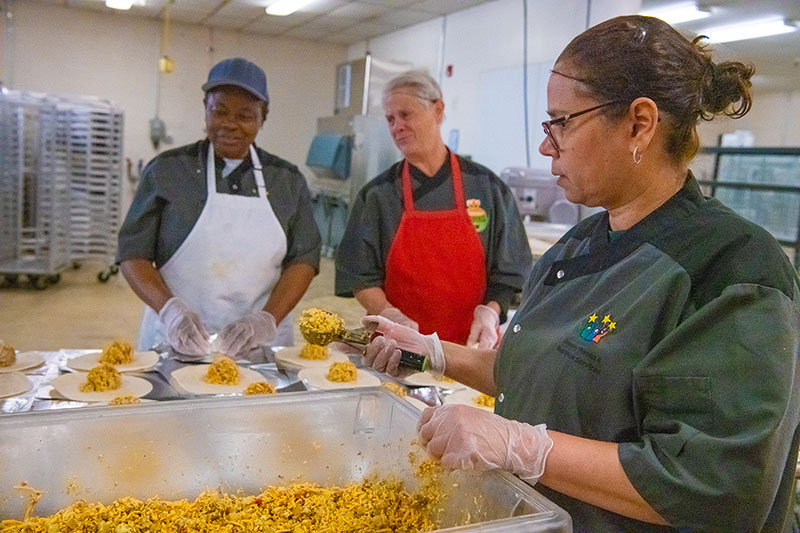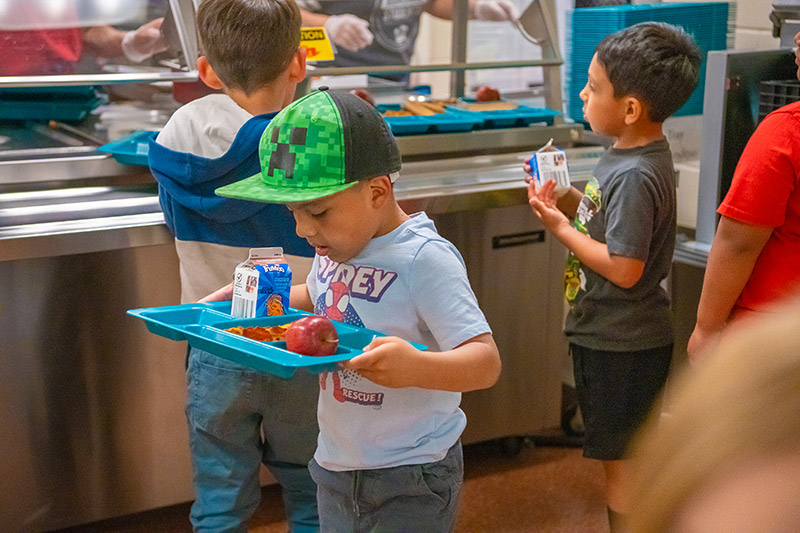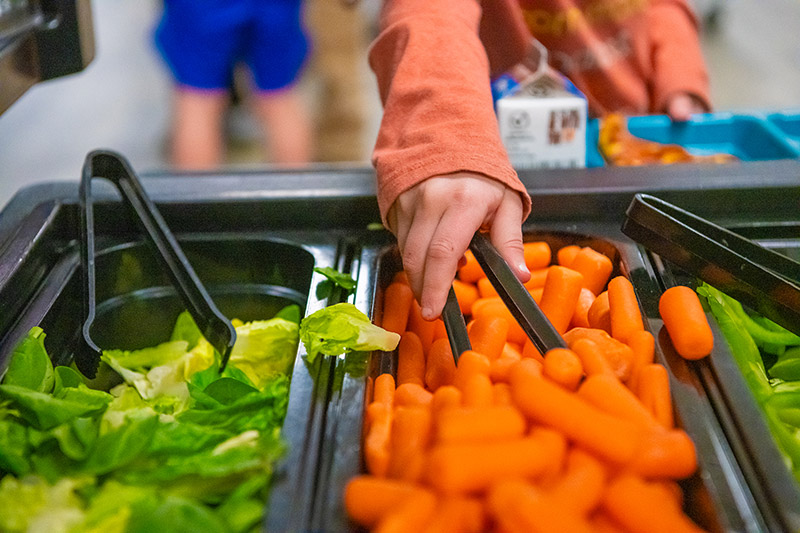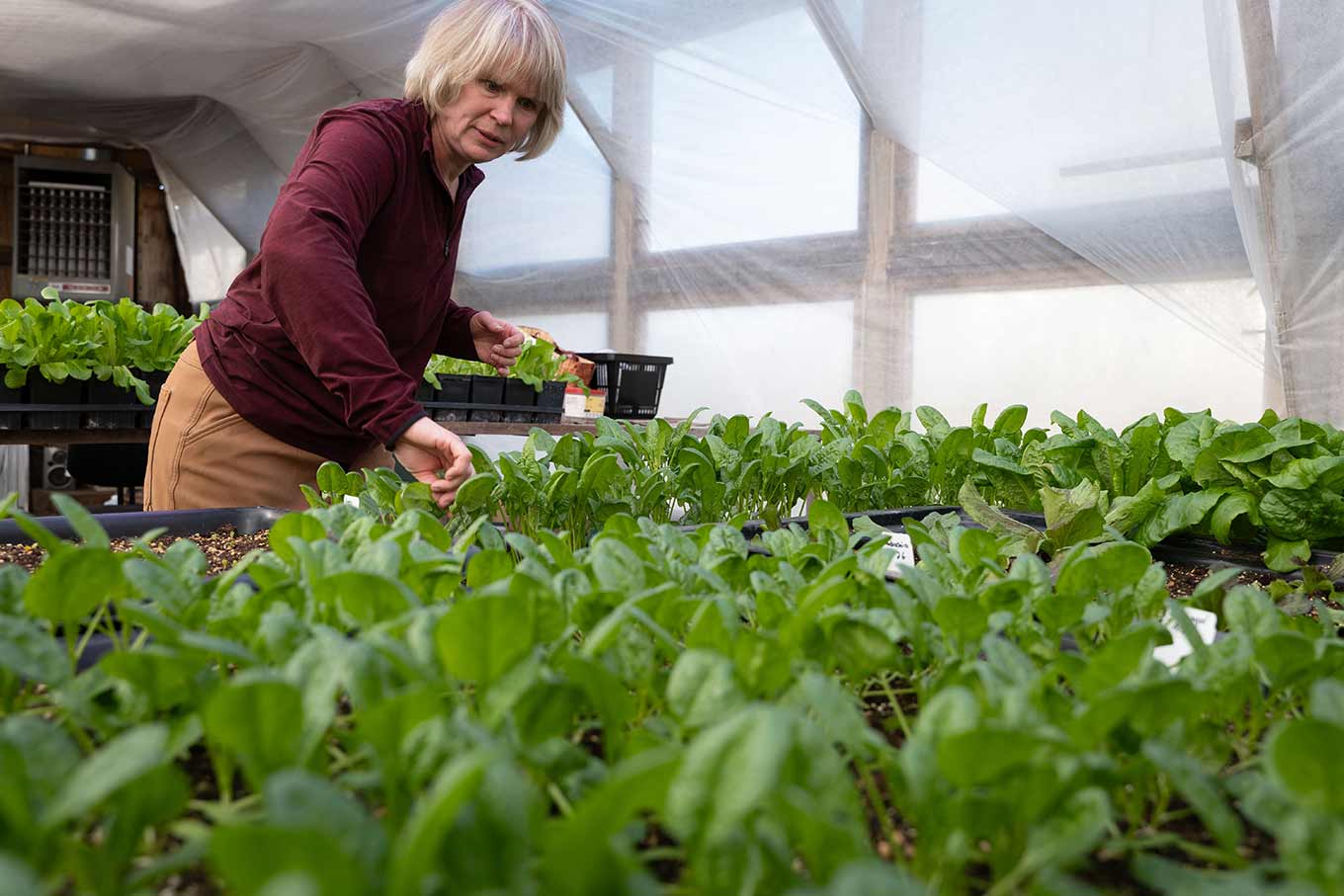Getting kids to eat more vegetables can be a fraught endeavor. But the nutrition team at Greeley-Evans School District 6 in Weld County found a solution: When Colorado-grown produce is an option in the schools’ cafeteria lunches, students flock to the salad bar.
“Our kitchen staff will share with us that when it is local broccoli or it’s hydroponically grown lettuce, students just gravitate to it more,” said Kara Sample, assistant director of nutrition services for the district.
Thanks to a federal initiative known as the Local Food for Schools Cooperative Agreement Program (LFS), Greeley-Evans School District 6 has been able to increase its local food offerings in recent years. LFS provided the district with more than $238,000 to spend on local food. Staff used those funds to purchase a wide array of Colorado-grown produce—including chili peppers, onions, tomatoes, zucchini, carrots, potatoes, broccoli, apples, peaches and pears—along with locally sourced beef and bison.
Greeley-Evans School District 6, which serves an average of 8,500 breakfasts and 14,000 lunches daily, was banking on additional funds from LFS to grow its local food offerings for the upcoming school year.
But in March, the USDA axed the program entirely. The rationale: The program “no longer effectuates agency priorities,” according to a letter sent to state agencies, as reported by the National Farm to School Network, a nonprofit organization that works to improve access to local food and nutrition education across the U.S.
“There’s a lot that is unfortunate about this decision, but the timing of it couldn’t have been worse,” said Danielle Bock, director of nutrition services for Greeley-Evans School District 6.

Food service workers, from left to right, Abiba Adam, Marla Lehman and Laura Fuentes, prepare breakfast burritos on Thursday, May 8, 2025, at the Central Production Kitchen where bulk food items are prepared in Greeley, Colo., before being distributed to schools in the Greeley-Evans School District 6. Photo by Tanya Fabian / Special to The Colorado Trust
In early February, about a month before the program cancellation, the district had awarded bids to seven local producers for the upcoming school year. Bock said she plans to honor those commitments, but as a result, “we’re going to have to reduce the quality and/or quantity of other choices on our menu.”
Launched in 2022, LFS provided funds to states so that public schools could purchase local food. In the first round of LFS, which ran from 2022 to 2024, Colorado received $2.6 million for K-12 schools. The Colorado Department of Education managed the funds and doled them out to 33 school districts, which then used the money to buy food from 135 local vendors, including farmers, ranchers, distributors and food hubs, according to Jess Wright, a director at Nourish Colorado, a statewide nonprofit (and past Colorado Trust grantee) that promotes access to fresh, nutritious food.
Wright said most vendors were small businesses, receiving roughly $1.1 million in funding. The second round of funding was poised to be even bigger, with $5.9 million slated for Colorado’s public K-12 schools and an additional $1.7 million reserved for state child care centers over three years.
Karen Spangler, policy director of the National Farm to School Network, said the funding “is not easily replaced by other sources.”
“I just cannot understand why the government would cut any program that directly supports the health and well-being of our children,” said Kim Cotta, director of nutrition services at Ignacio School District 11-JT in southwest Colorado, where 53% of students qualify for free or reduced-price lunch, higher than the statewide average (45%). “It’s a huge loss.”
Thanks to the first round of LFS, which awarded her district $4,504, Cotta was able to buy fresh raspberries, pumpkins, tomatoes, apples, peppers, plums and peaches from local farmers; pinto beans from Adobe Milling in Dove Creek; and dried chili from Fernandez Chili Company in Alamosa.

Pinto beans, grown by Hungenberg Produce in Weld County, fill a container photographed in a Greeley-Evans School District 6 warehouse on Thursday, May 8, 2025, in Greeley, Colo. Photo by Tanya Fabian / Special to The Colorado Trust
The spices from Fernandez, which were used in dishes including Frito pie, were “a favorite,” Cotta said. But with the funding loss, she won’t be able to make some of these purchases anymore, though she said she’s still committed to buying some local food. The district serves about 550 student lunches and 300 breakfasts a day.
“Fewer local purchases by schools can affect rural economies and impact jobs and community stability,” Cotta said. “The more I think about it, the more concerning it is to me. I see nutritional setbacks. I see reduced community partnerships.”
Mesa County Valley School District 51 on the Western Slope, which serves about 10,000 lunches and 5,000 breakfasts daily, received $85,005 from the first round of LFS. Dan Sharp, the district’s food and nutrition services director, said all that money went toward buying more local fruit, including apples and pears.
“We really wanted to be able to do apples all through from harvest in September until they run out, usually in November,” Sharp said. But due to the funding cut, “we’ve had to scale that back.”
Instead of apples grown on Colorado’s Western Slope, the district will buy cheaper apples, likely grown in Washington state, through a larger vendor and distributor. Colorado versus Washington-grown apples may not seem like a big deal. But serving local foods helps stoke regional pride among students, Sharp said. Plus, “trying to keep those local dollars in our community is very important to us,” he added.
Farm-to-school programs allow schools to access better-quality foods and increase students’ fruit and vegetable intake, according to research. Other research shows that kids who eat more fruits and veggies tend to have better mental health.

Dos Rios Elementary School student Emerson Lopez Torres, 5, looks down at the lunch tray he’s carrying in the school cafeteria on Thursday, May 8, 2025, in Greeley, Colo. Photo by Tanya Fabian / Special to The Colorado Trust
Wright said the LFS money could not be used to purchase ultra-processed foods. Research links a higher consumption of ultra-processed foods, like fast food, fried items and sweets, with lower academic performance and health issues that include cancer, heart disease and mental health disorders.
Providing kids with nutritious, local food is “not just a line item on a budget; this is an investment in their future,” said Roberto Meza, CEO of Hearty Provisions, a Denver-based organization that partners with local farmers to distribute their products to schools, hospitals and restaurants, among other establishments. Hearty Provisions works with about 10 school districts, including Greeley-Evans 6, and helped spread the word about the LFS first-round funding so districts could apply.
Meza pointed out that many students struggle to get enough to eat at home. In 2022, 14.2% of Colorado kids were food insecure, according to the nonprofit Feeding Colorado, which can make school “the only place where they can get a decent meal.” And if struggling families can’t count on kids getting quality nutrition at school, they may have to make concessions elsewhere, such as housing.
“It just exacerbates the current economic inequality that we’ve been facing for decades,” Meza said.
With reduced funding to support local purchasing, “school districts are having to continue with the status quo of low-quality, cheap food from big corporate players that have no interest in supporting local economies,” Meza said. “It’s just about volume and scale and bottom line rather than values, quality and nutrition.”
Adding to the challenge is that food costs in the U.S. have increased significantly since the COVID-19 pandemic, climbing 23.6% from 2020 to 2024, far outpacing inflation. The price of some items, such as proteins that Cotta purchases for school meals, has soared as much as 30% in the past five years, Meza said.
Schools receive about $4.50 per meal in federal reimbursement, which goes toward food, labor and overhead expenses, Sharp said. Yet, due to inflation and increased labor costs, “the reimbursement truly is not enough.”
Given the financial hurdles, Wright estimates that of Colorado’s 179 school districts, fewer than 20 will continue to buy local food. Wright said the LFS termination will disproportionately affect small and medium-sized school districts, especially those in rural areas. That’s because they often don’t have the staffing and budget resources that larger urban districts do to forge connections with local farmers and manage the logistics of purchasing their products.

Dos Rios Elementary School student Sumayah Nur Boshor, 6, raises her hand as fellow students next to her Saul Carmona, 5, and across the table, Analexi Espino, 6, Rudy Lujan II, 6, Lola Adame, 5, and Rosalie Sklar Ybarra Santos, 6, eat lunch in the school cafeteria on Thursday, May 8, 2025, in Greeley, Colo. Photo by Tanya Fabian / Special to The Colorado Trust
Local food advocates saw LFS as a way to continue the momentum created by existing state programs. In 2019, the Colorado legislature passed a law establishing a three-year grant program through the Colorado Department of Education to distribute $500,000 yearly to schools to purchase locally grown, raised or processed products. Led by Nourish Colorado, the legislation also included $150,000 annually for training and technical assistance to help schools connect with farmers and buy, prepare and promote their products. The initiative, called the Local Food Program, kicked off during the 2021-22 school year.
In 2022, Colorado lawmakers passed a bill to establish the Healthy School Meals for All Program. It provides free breakfast and lunch for all students in Colorado public schools. The legislation was also supposed to include grants to help schools purchase more local food—essentially expanding the existing Local Food Program—along with wage increases for cafeteria workers.
Yet program components were delayed because more students than anticipated accessed the free meals, which used up the funding. However, the Joint Budget Committee approved extending the original Local Food Program for a fourth year, infusing another $500,000 into public schools to purchase local food.
Even so, “that’s a small bit of money,” Wright said, which is why the larger-scale federal LFS program was so exciting for farm-to-school advocates. “We saw that as a bridge to effectively strengthen the value of the statewide Local Food Program that we’re trying to move toward underneath Healthy School Meals for All.”
The funding loss has deeply impacted Colorado growers and producers, Wright added. With the cancellation of LFS, “it is literally $7.6 million going directly into the hands of farmers and ranchers that is now not happening.”
Sarajane Snowden, owner of Snowden Meats, a family-run cattle ranch in northwest Colorado, said because of LFS, the Greeley-Evans School District 6 placed regular bulk ground-beef orders from her ranch this past year, becoming the company’s first—and only—bulk client.
“Getting to sell with the schools has been a huge opportunity for us,” she said.
She signed a year-long contract with the district that guaranteed it would buy her product for a certain price. Snowden said that the predictable revenue was beneficial for managing loans and other aspects of the business, especially amidst the volatility of the beef market. Plus, the contract provided more work to the local packer and delivery team she partners with to distribute her product.
“It’s impacting our rural area a lot,” she said.
The Greeley-Evans School District 6 committed to buying Snowden’s product for the upcoming school year, but without the federal funding, she predicts it’ll be hard to grow the bulk ground-beef side of her business. Before the LFS termination was announced, she submitted bids to sell her product to several other school districts, but now she’s unsure if those will come to fruition.
Alongside the LFS termination, the USDA axed the Local Food Purchase Assistance Cooperative Agreement Program (LFPA) in March. This separate pandemic-era initiative was set to provide Colorado with $5.5 million so that food pantries, food banks and public benefit programs could purchase local food.
Before these programs were canceled, farmers invested in infrastructure, seeding and labor with the expectation that they’d receive sales fueled by the funds.
“The thing with agriculture is that it’s very unlike the convenience of going to a grocery store and getting what you need,” Meza said. “We have to really be thoughtful about the planning that goes into it because it takes a while for those crops to be ready, and it takes the commitment of districts to be able to receive them.”

A Dos Rios Elementary School student uses tongs to grab a serving of carrots during lunch on Thursday, May 8, 2025, in Greeley, Colo. Photo by Tanya Fabian / Special to the Colorado Trust
With the new uncertainty, growers are forced to pivot and find alternative buyers for the crops they have already planted. “It’s going to impact the entire supply chain, especially those small, rural family farms,” Meza said.
Moreover, when farmers and ranchers send their products to larger, non-local distribution channels, they lose profit, Wright said. That’s because a percentage is taken off the top each time food is moved that way.
Without local sales, “in general, most of our farms are really only receiving 25 to 40 cents—maybe, in a best-case scenario, 50 cents on the dollar—of what that product may have cost,” Wright said. “The more we can keep this close and do these direct connections, that $1 is $1.”
The USDA also recently terminated this year’s $10 million round of federal Farm to School grants. Nourish Colorado had applied for nearly $500,000 in funding, with the organization and its partners pledging to match an additional $166,000 if the grant was awarded.
The funds would have been used to create a database to help K-12 institutions find and connect with Colorado producers who sell their products to schools, and also to develop a school meal recipe book so families could make meals featuring local products at home.
The Colorado Department of Education had also applied for funding, seeking about $237,000, with an additional $103,250 in matching funds, to create a Farm to School Institute program in northern Colorado.
Amidst these financial setbacks, a small silver lining is that Meza sees the funding cuts as a chance for innovation. “What new projects, pilots, models, maybe philanthropic roles can come into play to continue the work that we’ve been building?” he asked.
“We’re in it for the long game,” he added. “I know this is just a bump in the road.”









